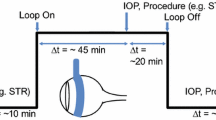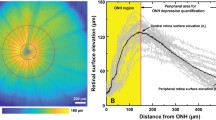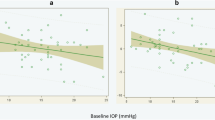Abstract
Background
Over the past few years the rat has gained prominence as an animal model for the study of glaucoma. However, no systematic study of the angle structures and the effects of medications on angle anatomy in the rat has been reported to date. We investigated the normal rat anterior segment anatomy in vivo using ultrasound biomicroscopy (UBM) and determined the effect of both cholinergic and anticholinergic medications on angle structures.
Methods
Fourteen eyes of seven 2-month-old female Wistar rats were imaged using an ultrasound biomicroscope and a modified eyecup. Baseline measurements of the anterior chamber depth (ACD), trabecular-iris angle (TIA), iris thickness at the thickest point near the pupillary margin (IT), angle-opening distance (AOD) (distance between the posterior corneal surface and anterior iris surface measured at 200 μm from the scleral spur), corneal thickness (CT) and irido-zonular distance (IZD) were obtained. Imaging was repeated 30 min after instillation of one drop of cyclopentolate 1% and 48 h later 30 min after pilocarpine 1% instillation. The same measurements were obtained and compared to baseline values.
Results
Baseline values for all parameters recorded were not significantly different among contralateral eyes. After instillation of either pilocarpine or cyclopentolate, ACD was the only parameter that did not change significantly from baseline. In contrast, TIA, AOD, IZD, and IT were significantly different among the three groups. Post-hoc analysis (Bonferroni test) revealed differences among all three groups of eyes for TIA and AOD. A difference was also found between the pilocarpine-treated group and the other two groups for IZD and IT. A very small difference detected between the pilocarpine-treated group and the baseline measurements for CT was caused by the zero variance of measurements in the former group. Although both pilocarpine and cyclopentolate induced angle narrowing, inspection of the ultrasonic images revealed a differential effect. Pilocarpine caused a “pupillary block-like” picture, while cyclopentolate caused crowding of the iris base in the angle.
Conclusions
Baseline characteristics of the normal rat anterior chamber anatomy were established. Both cyclopentolate and pilocarpine cause angle narrowing in the rat eye, by different mechanisms.




Similar content being viewed by others
References
Balidis MO, Bunce C, Sandy CJ, Wormald RP, Miller MH (2002) Iris configuration in accommodation in pigment dispersion syndrome. Eye 16(6):694–700
Bayer AU, Danias J, Brodie S, Maag KP, Chen B, Shen F, Podos SM, Mittag TW (2001) Electroretinographic abnormalities in a rat glaucoma model with chronic elevated intraocular pressure. Exp Eye Res 72(6):667–677
Calhoun FP Jr (1975) The management of glaucoma in nanophthalmos. Trans Am Ophthalmol Soc 73:97–122
Garcia-Valenzuela E, Shareef S, Walsh J, Sharma SC (1995) Programmed cell death of retinal ganglion cells during experimental glaucoma. Exp Eye Res 61(1):33–44
John SW, Smith RS, Savinova OV, Hawes NL, Chang B, Turnbull D, Davisson M, Roderick TH, Heckenlively JR (1998) Essential iris atrophy, pigment dispersion, and glaucoma in DBA/2J mice. Invest Ophthalmol Vis Sci 39(6):951–962
Kobayashi H, Kobayashi K, Kiryu J, Kondo T (1997) Ultrasound biomicroscopic analysis of the effect of pilocarpine on the anterior chamber angle. Graefes Arch Clin Exp Ophthalmol 235(7):425–430
Kobayashi H, Kobayashi K, Kiryu J, Kondo T (1999) Pilocarpine induces an increase in the anterior chamber angular width in eyes with narrow angles. Br J Ophthalmol 83(5):553–558
Levkovitch-Verbin H, Quigley HA, Martin KR, Valenta D, Baumrind LA, Pease ME (2002) Translimbal laser photocoagulation to the trabecular meshwork as a model of glaucoma in rats. Invest Ophthalmol Vis Sci 43(2):402–410
Liebmann JM, Tello C, Chew SJ, Cohen H, Ritch R (1995) Prevention of blinking alters iris configuration in pigment dispersion syndrome and in normal eyes. Ophthalmology 102(3):446–455
Morrison JC, Moore CG, Deppmeier LM, Gold BG, Meshul CK, Johnson EC (1997) A rat model of chronic pressure-induced optic nerve damage. Exp Eye Res 64(1):85–96
Pavlin CJ, Harasiewicz K, Foster FS (1995) An ultrasound biomicroscopic dark-room provocative test. Ophthalmic Surg 26(3):253–255
Pavlin CJ, Macken P, Trope GE, Harasiewicz K, Foster FS (1996) Accommodation and iridotomy in the pigment dispersion syndrome. Ophthalmic Surg Lasers 27(2):113–120
Pavling CJ, Foster FS (1992) Ultrasound biomicroscopy of the eye. Acta Ophthalmol 204:S7–S9
Schulz D, Iliev ME, Frueh BE, Goldblum D (2003) In vivo pachymetry in normal eyes of rats, mice and rabbits with the optical low coherence reflectometer. Vis Res 43(6):723–728
Ueda J, Sawaguchi S, Hanyu T, Yaoeda K, Fukuchi T, Abe H, Ozawa H (1998) Experimental glaucoma model in the rat induced by laser trabecular photocoagulation after an intracameral injection of India ink. Jpn J Ophthalmol 42(5):337–344
Acknowledgements
Supported in part by an unrestricted grant from Research to Prevent Blindness, Inc, New York, NY, grants EY01867, K08 EY00390, from the National Institutes of Health, Bethesda, MD, a grant from the Fund for Ophthalmic Knowledge, Inc and a grant from the Eye Bank for Sight Restoration.
Author information
Authors and Affiliations
Corresponding author
Additional information
Nicholas Nissirios and Jerome Ramos-Esteban contributed equally and should both be considered first authors.
Rights and permissions
About this article
Cite this article
Nissirios, N., Ramos-Esteban, J. & Danias, J. Ultrasound biomicroscopy of the rat eye: effects of cholinergic and anticholinergic agents. Graefe's Arch Clin Exp Ophthalmol 243, 469–473 (2005). https://doi.org/10.1007/s00417-004-1061-1
Received:
Revised:
Accepted:
Published:
Issue Date:
DOI: https://doi.org/10.1007/s00417-004-1061-1




